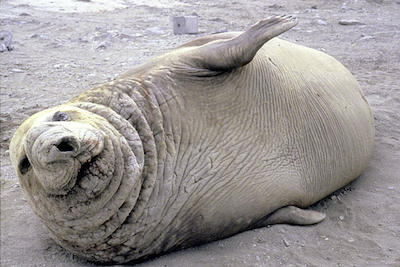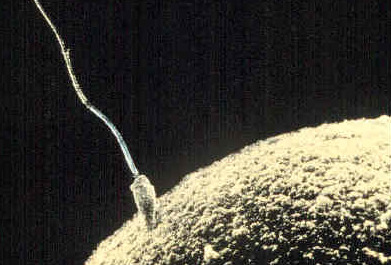Mating Behavior
As scandalous as it may seem to a 15th century pope, most animals do not settle down with one partner for the rest of their lives, but instead have different partners in each mating season. Animals have lots of different types of mating behavior. These include:
Polygyny, when a single male mates with multiple females, is the most common mating system in the animal kingdom. In polygynous systems, the males fight for dominance over a group of females, and whichever male is the biggest and strongest gets to mate with all the females. Lions and elephant seals use this type of mating system.

A female elephant seal, waiting for her Prince Charming. Image from here.
Before you go calling all of our animal friends sexist, let’s just think about the biology of reproduction. To make another animal, you need an egg and a sperm, unless you spring fully formed from the head of Zeus. Making eggs takes a lot of energy, and we’re not talking about the electricity required to power an egg poacher. Eggs are a lot bigger than sperm, a lot of animals only make one at a time, and cannot make them after a certain age.

Eggs are huge compared to sperm. In this picture, the sperm (the little thing with a tail) is dwarfed by the egg (the huge orb). Image from here.
Sperm, on the other hand are cheap to make, biologically speaking, and can be made throughout a male’s life. So, if a female is investing a lot of time and energy into her eggs, she wants to make sure she mates with the best male so that her offspring have a good chance of survival. Sometimes, the best male just means the biggest and strongest. As the logic goes, big strong males will have big strong offspring, and those offspring are most likely to survive.
Keeping the kiddos safe is quite a job, and some animal species just don’t bother with it at all. Reptiles and insects do not make great parents. They sort of get the eggs out and then move on with their lives, letting their babies fend for themselves. On the plus side, insects never have to worry about what to give their mom for Mother’s Day.
Other animals, including mammals and birds, stick around to raise their offspring. This is called parental care; in other words, parents taking care of their babies. In most birds and mammals, mothers are the ones who take care of the offspring and fathers are not in the picture. In some aquatic animals though (fish, for example), fathers take care of the babies, just like in Finding Nemo. So what’s the deal? Why are fish better dads than mammals are?
It has to do with fertilization and paternity. You see, the males want to be sure that they really are the dad—they haven’t learned about paternity tests yet. In animals with internal fertilization, where the egg and sperm meet inside the female body, males can’t be sure that someone else didn’t already fertilize the egg. Looking at this from a genetic fitness perspective, it is a waste of the male’s energy for him to take care of babies that don’t carry his genes. Fitness = survival + reproduction, and the males need to be sure they actually did reproduce.
In animals with external fertilization, such as amphibians, reptiles and fish, the male can be sure that the offspring are getting his genes because he fertilizes the eggs as they are laid. Look at frogs and toads. The male grabs the female and fertilizes the eggs as they come out, not letting go until he’s done, sometimes not for days. This mating position is called an amplexus.

Common toads (Bufo bufo) in an amplexus. The male is on top of the female. Hubba Hubba. Image from here.
In some external fertilization situations, males might guard or carry the eggs to be sure they actually develop and hatch. Seahorses exhibit an extreme form of this "role reversal," with the male taking responsibility for the babies. Male seahorses carry around the developing offspring in a pouch. The female deposits eggs into his pouch, which the male fertilizes. While the fertilized eggs develop, the female seahorse comes back to check on the male and spends time with him each day until he gives birth. Yup, the male gives birth. Weird, right?
Other interesting male parental care includes: jawfish, who carry around the eggs in their mouths, the California mouse, who helps raise the babies, and humans. Hey, we are animals too, after all.

Swordtail jawfish, showing off its big mouth where it carries around the eggs. Image from here.
- monogamy, when two animals mate exclusively with each other (1 partner)
- polygamy, when animals have multiple different mating partners
- polygyny, when one male mates with multiple females
- polyandry, when one female mates with multiple males
Polygyny, when a single male mates with multiple females, is the most common mating system in the animal kingdom. In polygynous systems, the males fight for dominance over a group of females, and whichever male is the biggest and strongest gets to mate with all the females. Lions and elephant seals use this type of mating system.

A female elephant seal, waiting for her Prince Charming. Image from here.
Before you go calling all of our animal friends sexist, let’s just think about the biology of reproduction. To make another animal, you need an egg and a sperm, unless you spring fully formed from the head of Zeus. Making eggs takes a lot of energy, and we’re not talking about the electricity required to power an egg poacher. Eggs are a lot bigger than sperm, a lot of animals only make one at a time, and cannot make them after a certain age.

Eggs are huge compared to sperm. In this picture, the sperm (the little thing with a tail) is dwarfed by the egg (the huge orb). Image from here.
Sperm, on the other hand are cheap to make, biologically speaking, and can be made throughout a male’s life. So, if a female is investing a lot of time and energy into her eggs, she wants to make sure she mates with the best male so that her offspring have a good chance of survival. Sometimes, the best male just means the biggest and strongest. As the logic goes, big strong males will have big strong offspring, and those offspring are most likely to survive.
Keeping the kiddos safe is quite a job, and some animal species just don’t bother with it at all. Reptiles and insects do not make great parents. They sort of get the eggs out and then move on with their lives, letting their babies fend for themselves. On the plus side, insects never have to worry about what to give their mom for Mother’s Day.
Other animals, including mammals and birds, stick around to raise their offspring. This is called parental care; in other words, parents taking care of their babies. In most birds and mammals, mothers are the ones who take care of the offspring and fathers are not in the picture. In some aquatic animals though (fish, for example), fathers take care of the babies, just like in Finding Nemo. So what’s the deal? Why are fish better dads than mammals are?
It has to do with fertilization and paternity. You see, the males want to be sure that they really are the dad—they haven’t learned about paternity tests yet. In animals with internal fertilization, where the egg and sperm meet inside the female body, males can’t be sure that someone else didn’t already fertilize the egg. Looking at this from a genetic fitness perspective, it is a waste of the male’s energy for him to take care of babies that don’t carry his genes. Fitness = survival + reproduction, and the males need to be sure they actually did reproduce.
In animals with external fertilization, such as amphibians, reptiles and fish, the male can be sure that the offspring are getting his genes because he fertilizes the eggs as they are laid. Look at frogs and toads. The male grabs the female and fertilizes the eggs as they come out, not letting go until he’s done, sometimes not for days. This mating position is called an amplexus.

Common toads (Bufo bufo) in an amplexus. The male is on top of the female. Hubba Hubba. Image from here.
In some external fertilization situations, males might guard or carry the eggs to be sure they actually develop and hatch. Seahorses exhibit an extreme form of this "role reversal," with the male taking responsibility for the babies. Male seahorses carry around the developing offspring in a pouch. The female deposits eggs into his pouch, which the male fertilizes. While the fertilized eggs develop, the female seahorse comes back to check on the male and spends time with him each day until he gives birth. Yup, the male gives birth. Weird, right?
Other interesting male parental care includes: jawfish, who carry around the eggs in their mouths, the California mouse, who helps raise the babies, and humans. Hey, we are animals too, after all.

Swordtail jawfish, showing off its big mouth where it carries around the eggs. Image from here.